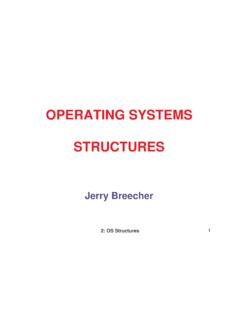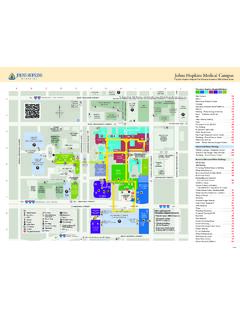Transcription of OPERATING SYSTEMS PROCESS SYNCHRONIZATION - WPI
1 OPERATING SYSTEMS . PROCESS SYNCHRONIZATION . Jerry Breecher 6: PROCESS SYNCHRONIZATION 1. OPERATING SYSTEM. SYNCHRONIZATION What Is In This Chapter? This is about getting processes to coordinate with each other. How do processes work with resources that must be shared between them? How do we go about acquiring locks to protect regions of memory? How is SYNCHRONIZATION really used? 6: PROCESS SYNCHRONIZATION 2. OPERATING SYSTEM. SYNCHRONIZATION Topics Covered Background The Critical-Section Problem Peterson's Solution SYNCHRONIZATION Hardware Semaphores Classic Problems of SYNCHRONIZATION SYNCHRONIZATION Examples Atomic Transactions 6: PROCESS SYNCHRONIZATION 3.
2 PROCESS The Producer Consumer Problem SYNCHRONIZATION . A producer PROCESS "produces" information "consumed" by a consumer PROCESS . Here are the variables needed to define the problem: #define BUFFER_SIZE 10. typedef struct {. DATA data;. } item;. item buffer[BUFFER_SIZE];. int in = 0; // Location of next input to buffer int out = 0; // Location of next removal from buffer int counter = 0; // Number of buffers currently full Consider the code segments on the next page: Does it work? Are all buffers utilized? 6: PROCESS SYNCHRONIZATION 4. PROCESS The Producer Consumer Problem SYNCHRONIZATION #define BUFFER_SIZE 10.
3 A producer PROCESS "produces" information typedef struct {. "consumed" by a consumer PROCESS . DATA data;. } item;. item nextProduced; PRODUCER item buffer[BUFFER_SIZE];. int in = 0;. while (TRUE) { int out = 0;. while (counter == BUFFER_SIZE); int counter = 0;. buffer[in] = nextProduced;. in = (in + 1) % BUFFER_SIZE;. item nextConsumed;. counter++; CONSUMER. } while (TRUE) {. while (counter == 0);. nextConsumed = buffer[out];. out = (out + 1) %. BUFFER_SIZE;. counter--;. producer consumer }. 6: PROCESS SYNCHRONIZATION 5. PROCESS The Producer Consumer Problem SYNCHRONIZATION .
4 Note that counter++; this line is NOT what it seems!! is really --> register = counter register = register + 1. counter = register At a micro level, the following scenario could occur using this code: TO; Producer Execute register1 = counter register1 = 5. T1; Producer Execute register1 = register1 + 1 register1 = 6. T2; Consumer Execute register2 = counter register2 = 5. T3; Consumer Execute register2 = register2 - 1 register2 = 4. T4; Producer Execute counter = register1 counter = 6. T5; Consumer Execute counter = register2 counter = 4. 6: PROCESS SYNCHRONIZATION 6.
5 PROCESS . Critical Sections SYNCHRONIZATION . A section of code, common to n cooperating processes, in which the processes may be accessing common variables. A Critical Section Environment contains: Entry Section Code requesting entry into the critical section. Critical Section Code in which only one PROCESS can execute at any one time. Exit Section The end of the critical section, releasing or allowing others in. Remainder Section Rest of the code AFTER the critical section. 6: PROCESS SYNCHRONIZATION 7. PROCESS . Critical Sections SYNCHRONIZATION . The critical section must ENFORCE ALL THREE of the following rules: Mutual Exclusion: No more than one PROCESS can execute in its critical section at one time.
6 Progress: If no one is in the critical section and someone wants in, then those processes not in their remainder section must be able to decide in a finite time who should go in. Bounded Wait: All requesters must eventually be let into the critical section. 6: PROCESS SYNCHRONIZATION 8. PROCESS . Two Processes SYNCHRONIZATION Software Here's an example of a simple piece of code containing the components required in a critical section. do {. Entry Section while ( turn ^= i );. /* critical section */ Critical Section turn = j;. /* remainder section */ Exit Section } while(TRUE).
7 Remainder Section 6: PROCESS SYNCHRONIZATION 9. PROCESS . Two Processes SYNCHRONIZATION Software Here we try a succession of increasingly complicated solutions to the problem of creating valid entry sections. NOTE: In all examples, i is the current PROCESS , j the "other" PROCESS . In these examples, envision the same code running on two processors at the same time. TOGGLED ACCESS: do {. while ( turn ^= i );. Algorithm 1. /* critical section */. turn = j;. /* remainder section */ Are the three Critical Section } while(TRUE); Requirements Met? 6: PROCESS SYNCHRONIZATION 10.
8 PROCESS . Two Processes SYNCHRONIZATION Software FLAG FOR EACH PROCESS GIVES STATE: Each PROCESS maintains a flag indicating that it wants to get into the critical section. It checks the flag of the other PROCESS and doesn't enter the critical section if that other PROCESS wants to get in. Shared variables boolean flag[2];. initially flag [0] = flag [1] = false. Algorithm 2. flag [i] = true Pi ready to enter its critical section do {. flag[i] := true; Are the three Critical while (flag[j]) ; Section Requirements Met? critical section flag [i] = false;. remainder section } while (1).
9 6: PROCESS SYNCHRONIZATION 11. PROCESS . Two Processes SYNCHRONIZATION Software FLAG TO REQUEST ENTRY: Each processes sets a flag to request entry. Then each PROCESS toggles a bit to allow the other in first. This code is executed for each PROCESS i. Algorithm 3. Shared variables boolean flag[2];. initially flag [0] = flag [1] = false. flag [i] = true Pi ready to enter its critical section Are the three Critical Section Requirements Met? do {. flag [i]:= true;. turn = j;. while (flag [j] and turn == j) ; This is Peterson's critical section Solution flag [i] = false.}
10 Remainder section } while (1); 6: PROCESS SYNCHRONIZATION 12. PROCESS Critical Sections SYNCHRONIZATION . The hardware required to support critical sections must have (minimally): Indivisible instructions (what are they?). Atomic load, store, test instruction. For instance, if a store and test occur simultaneously, the test gets EITHER the old or the new, but not some combination. Two atomic instructions, if executed simultaneously, behave as if executed sequentially. 6: PROCESS SYNCHRONIZATION 13. PROCESS Hardware SYNCHRONIZATION Solutions Disabling Interrupts: Works for the Uni Processor case only.











